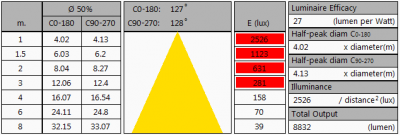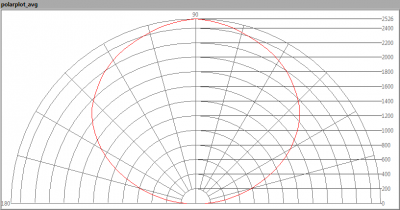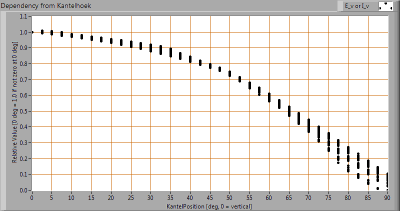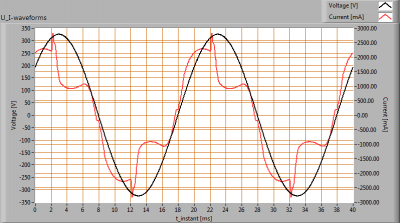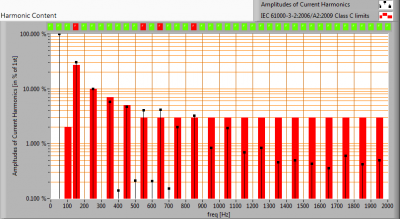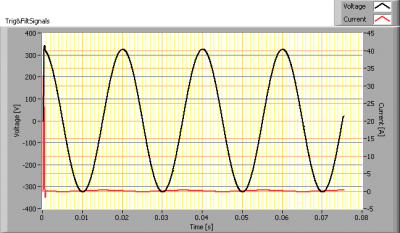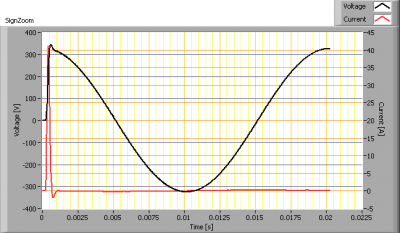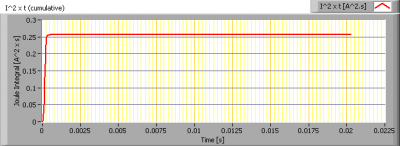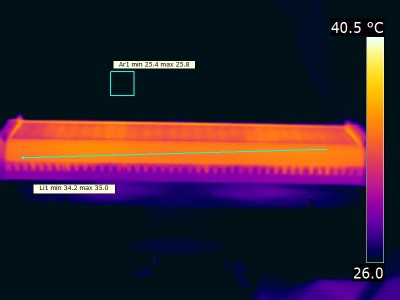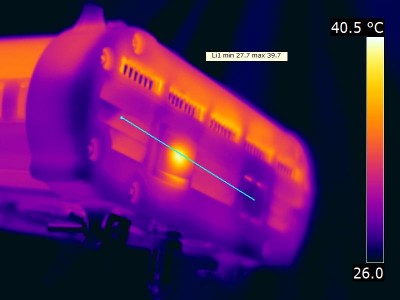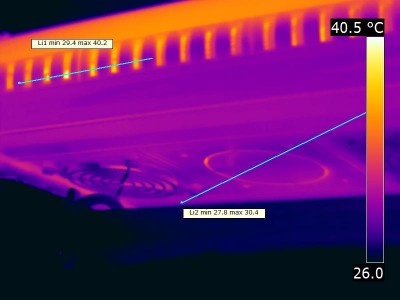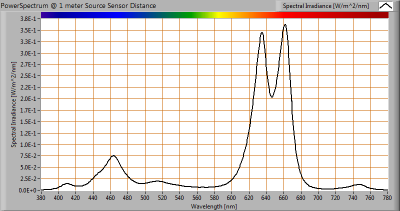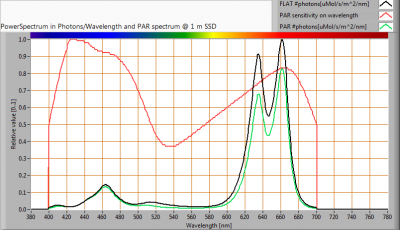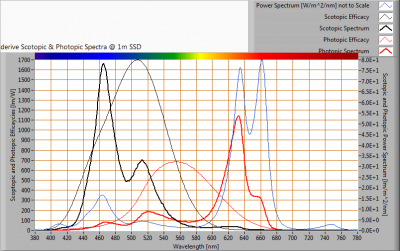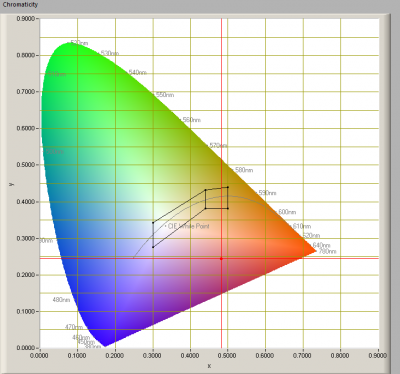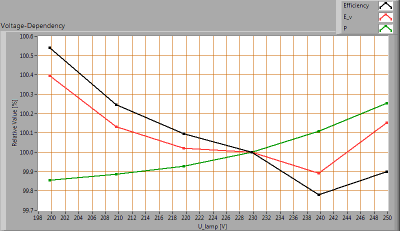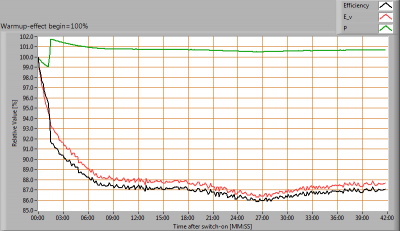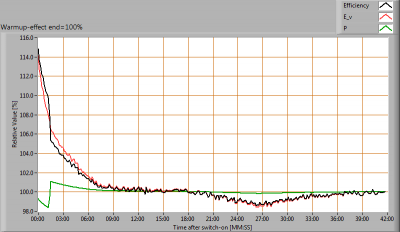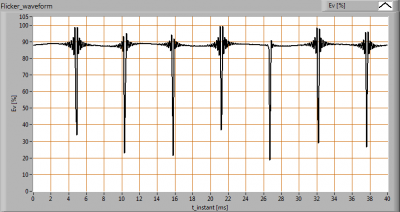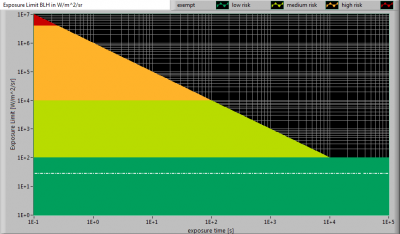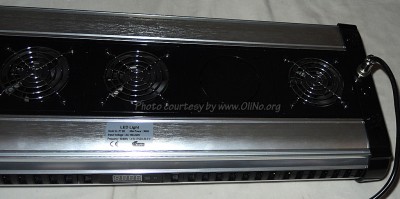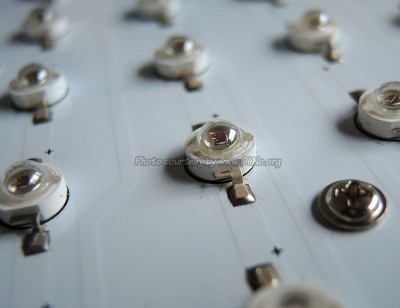![]() presents an LED plantgrown light. The measurements from OliNo show that the lamp consumes 321.4 W and has a luminous flux of 8832 lm or a photocurrent of 364 micromol/s.
presents an LED plantgrown light. The measurements from OliNo show that the lamp consumes 321.4 W and has a luminous flux of 8832 lm or a photocurrent of 364 micromol/s.
This article shows the measurement results. Many parameters are also found in the Eulumdat file.
See this overview for a comparison with other light bulbs.
Summary measurement data
| parameter | meas. result | remark |
|---|---|---|
| Luminous intensity Iv | 2525.7 Cd | Measured straight underneath the lamp. |
| Illuminance modulation index | 68 % | Measured with a light sensor looking at the lamp (angle not defined). Is a measure for the amount of flickering. |
| Beam angle | 128 deg | 127 deg is the beam angle for the C0-C180-plane (perpendicular to the length direction of the lamp) and 128 deg is the beam angle for the C90-C270 plane, which is along the length direction of the lamp. |
| Power P | 321.4 W | Follow the link for more information on electrical properties. |
| Power Factor | 0.90 | An electrical load with this power factor means that for every 1 kWh net energy consumed, there has been 0.48 kVAhr for reactive energy. |
| THD | 34 % | Total Harmonic Distortion. |
| Max inrush current | 41.193 A | This current has been found at a voltage start angle of 90 degrees. |
| Luminous flux | 8832 lm | Measured with photogoniometer, calculation done as described in LM79-08. |
| Luminous efficacy | 27 lm/W | |
| Coordinates chromaticity diagram | x=0.4820 en y=0.2445 | |
| Fitting | 230V | This lamp is connected directly to the grid voltage. |
| PAR-value | 77.5 uMol/s/m2 | The number of photons seen by an average plant when it is lit by the light of this light bulb. Value valid at 1 m distance from light bulb. |
| PAR-photon efficacy | 0.8 uMol/s/We | The total emitted number of photons by this light, divided by its consumption in W. It indicates a kind of efficacy in generating photons. |
| Photon current | 363.5 uMol/s | The total number of photons in the light of this lamp. |
| S/P ratio | 1.7 | This factor indicates the amount of times more efficient the light of this light bulb is perceived under scotopic circumstances (low environmental light level). |
| L x W x H external dimensions | 730 mm x 235 mm x 85 mm | External dimensions of the lamp. |
| L x W luminous area | 655 mm x 140 mm | Dimensions of the luminous area (used in Eulumdat file). It is the area of the plate on which the LEDs are mount. |
| General remarks | The ambient temperature during the whole set of illuminance measurements was 26.4 – 27.0 deg C.The temperature of the housing gets maximally about 15 degrees hotter than ambient temperature. IR_EXTRAINFOWarm up effect: During the warmup time the illuminance varies during 6 minutes and decreases with 12 %. During the warmup time the power doesn’t vary significantly (< 5 %). The variation in efficacy (calculated as indication by simplydividing the illuminance by the power) during the warming up is -11 %. A very high negative value indicates a significant decrease for instance due to heating up of the lamp (decrease of lifetime). Voltage dependency: There is no (significant) dependency of the illuminance when the power voltage varies between 200 – 250 V AC. At the end of the article an additional photo. |
|
| Eff-variation | -11 % | This is the variation in efficacy (calculated as indication by simply dividing the illuminance by the power) during the warming up. A very high negative value indicates a significant decrease for instance due to heating up of the lamp (decrease of lifetime). |
| Dimmable | yes | Info from manufacturer. |
Biologic effect factor |
0.835 | According to pre-norm DIN V 5031-100:2009-06. |
| Blue Light Hazard risk group | 0 | 0=exempt, 1=low, 2 = moderate, 3=high risk. |
| form factor | pendant | |
| Eulumdat file |  |
Right click on icon and save the file. |
| Eulumdat file (with micromol/s instead of lm) |  |
Right click on icon and save the file. |
Overview table
The overview table is explained on the OliNo website.
Please note that this overview table makes use of calculations, use this data with care as explained on the OliNo site. E (lux) values are not accurate, when within 5 x 670 mm (maximal luminous size, eventually diagonally measured)= 3350 mm. Within this distance from the lamp (data given in red), the measured lux values will be less than the computed values in this overview as the measurements are then within the near field of the lamp.
Eulumdat light diagram
This light diagram below comes from the program Qlumedit, that extracts these diagrams from an Eulumdat file. This light diagram is explained on the OliNo site.
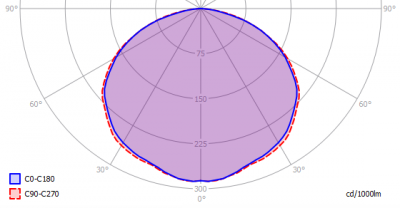
The light diagram giving the radiation pattern.
The light diagram indicates the beam in the C0-C180 plane (perpendicular to the length direction of the lamp) and in the plane perpendicular to that, the C90-C270 plane (along the length direction of the lamp).
Illuminance Ev at 1 m distance, or luminous intensity Iv
Herewith the plot of the averaged luminous intensity Iv as a function of the inclination angle with the light bulb.
The radiation pattern of the light bulb.
This radiation pattern is the average of the light output of the light diagram given earlier. Also, in this graph the luminous intensity is given in Cd.
These averaged values are used (later) to compute the lumen output.
Intensity data of every measured turn angle at each inclination angle.
This plot shows per inclination angle the intensity measurement results for each turn angle at that inclination angle. There normally are differences in illuminance values for different turn angles. However for further calculations the averaged values will be used.
When using the average values per inclination angle, the beam angle can be computed, being 127 deg for the C0-C180 plane and 128 deg for the C90-C270 plane.
Luminous flux
With the averaged illuminance data at 1 m distance, taken from the graph showing the averaged radiation pattern, it is possible to compute the luminous flux.
The result of this computation for this light spot is a luminous flux of 8832 lm.
Luminous efficacy
The luminous flux being 8832 lm, and the consumed power of the lamp being 321.4 Watt, results in a luminous efficacy of 27 lm/Watt.
Electrical properties
The power factor is 0.90. An electrical load with this power factor means that for every 1 kWh net energy consumed, there has been 0.48 kVAhr for reactive energy.
| Lamp voltage | 229.73 V |
| Lamp current | 1.552 A |
| Power P | 321.4 W |
| Apparent power S | 356.5 VA |
| Power factor | 0.90 |
Of this lamp the voltage across and the resulting current through it are measured and graphed. See the UI acquisition on the OliNo site how this is obtained.
Voltage across and current through the lightbulb
This current waveform has been checked on requirements posed by the norm IEC 61000-3-2:2006 (including up to A2:2009). See also the IEC 61000-3-2:2006 explanation on the OliNo website.
Harmonics in the current waveform and checked against IEC61000-3-2:2006 and A2:2009
When the consumed power is 25 W there are limits for the harmonics and those are not respected. See the note for additional explication.
The Total Harmonic Distortion of the current is computed and its value is 34 %.
Note: the used lampvoltage in this test is clean enough to be able to well evaluate the results of the current harmonics according to this norm. Herewith the image showing the harmonic content of the voltage used.
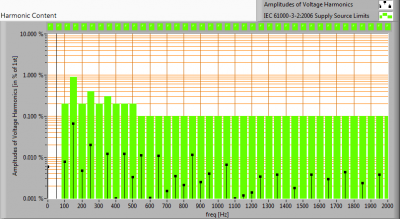
Harmonics in the voltage waveform and checked against IEC61000-3-2:2006 and A2:2009.
Inrush current
The inrush current has been measured for different voltage start angles; from 0 – 170 degrees with a 10 degrees step. The current- and voltage values have been acquires at a sample speed of 39.9 kS/s. Then this data has been fed into a second order 2kHz low pass Butterworth filter. This removes the current spikes that do not represent relevant values.
The lamp was two minutes off before every inrush current measurement was made.
| Test voltage | 230.0 V | |
| Frequency of the voltage | 50.0 Hz | |
| Maximum inrush current | 41.193 A | This current has been found at a voltage start angle of 90 degrees. |
| Pulse width of max inrush current | 1.5E-4 s | This is the time that the pulse is higher than 66 % of the max inrush current. |
| Minimal inrush current | 2.440 A | This current has been found at a voltage start angle of 0 degrees. |
| I^2 x t after 10 ms at 0 deg voltage start angle | 1.363E-2 A | This is the I^2 t value when a zero crossing detector is used to start the voltage from 0 degrees. |
Inrush current found at worst-case voltage start angle
First cycle of the maximum inrush current
The energy I2t during the first 10 ms of the first current cycle
Temperature measurements lamp
Temperature image(s).
| status lamp | 2 hours on |
| ambient temperature | 25.5 deg C |
| reflected background temperature | 25.5 deg C |
| camera | Flir T335 |
| emissivity | 0.95 |
| measurement distance | 0.5, 1.5 m |
| IFOVgeometric | 0.136 mm per 0.1 m distance |
| NETD (thermal sensitivity) | 50 mK |
Spectral power distribution
The spectral power distribution of this light bulb, energies on y-axis valid at 1 m distance.
PAR value and PAR spectrum
To make a statement how well the light of this light bulb is for growing plants, the PAR-area needs to be determined. See the explanation about PAR on the OliNo website how this all is determined and the explanation of the graph.
The photon spectrum, then the sensitivity curve and as result the final PAR spectrum of the light of this light bulb
| parameter | value | unit |
|---|---|---|
| PAR number | 77.5 | uMol/s/m^2 |
| PAR photon current | 271.1 | uMol/s |
| PAR photon efficacy | 0.8 | uMol/s/W |
The PAR efficiency is 77 % (valid for the PAR wave length range of 400 – 700 nm). This is the maximum percentage of the total of photons in the light that is effectively used by the average plant (since the plant might not take 100 % of the photons at the frequency where its relative sensitivity is 100 %).
S/P ratio
The S/P ratio and measurement is explained on the OliNo website. Here the results are given.
The power spectrum, sensitivity curves and resulting scotopic and photopic spectra (spectra energy content defined at 1 m distance).
The S/P ratio of the light coming from this lamp is 1.7.
More info on S/P ratio can be found on the OliNo website.
Chromaticity diagram
The chromaticity space and the position of the lamp’s color coordinates in it.
The point of the light in this diagram is outside the area indicated with class A. This area indicates an area for signal lamps, see also the article on signal lamps and color areas on the OliNo website.
The color coordinates are x=0.4820 and y=0.2445.
Voltage dependency
The dependency of a number of lamp parameters on the lamp voltage is determined. For this, the lamp voltage has been varied and its effect on the following light bulb parameters measured: illuminance E_v [lx], the lamppower P [W] and the luminous efficacy [lm/W] (this latter is estimated here by dividing the found E_v value by P).
Lamp voltage dependencies of certain light bulb parameters
There is no (significant) dependency of the illuminance when the power voltage varies between 200 – 250 V AC.
There is no (significant) dependency of the consumed power when the power voltage varies between 200 – 250 V AC.
When the voltage varies abruptly with + or – 5 V AC then this results in a variation of the illuminance of maximally 0.1 %. This difference in illuminance is not visible (when it occurs abruptly).
Warm up effects
After switch on of a cold lamp, the effect of heating up of the lamp is measured on illuminance E_v [lx], the lamppower P [W] and the luminous efficacy [lm/W].
Effect of warming up on different light bulb parameters. In the first graph the 100 % level is put at begin, and in the last graph the 100 % level is put at the end.
During the warmup time the illuminance varies during 6 minutes and decreases with 12 %.
During the warmup time the power doesn’t vary significantly ( 5 %).
The variation in efficacy (calculated as indication by simplydividing the illuminance by the power) during the warming up is -11 %. A very high negative value indicates a significant decrease for instance due to heating up of the lamp (decrease of lifetime).
Measure of flickering
An analysis is done on the measure of flickering of the light output by this light bulb. See the article on flickering on OliNo site for more information.
The measure of fast illuminance variation of the light of the light bulb
| parameter | value | unit |
|---|---|---|
| Flicker frequency | 549.2 | Hz |
| Illuminance modulation index | 68 | % |
The illuminance modulation index is computed as: (max_Ev – min_Ev) / (max_Ev + min_Ev).
Biologic effect
The biologic effect shows the level of impact the light of this lamp can have on the day-night rhythm of human beings (as well as the suppression of melatonin production). See also the explanatory article on biologic effect on OliNo.
The important parameters (according to prenorm DIN V 5031-100:2009-06):
| biologic effect factor | 0.835 |
| kbiol trans (25 years) | 1.000 |
| kbiol trans (50 years) | 0.730 |
| kbiol trans (75 years) | 0.445 |
| kpupil(25 years) | 1.000 |
| kpupil(50 years) | 0.740 |
| kpupil(75 years) | 0.519 |
Blue Light Hazard
The amount of blue light and the harm it can cause on the retina has been determined. Herewith the results.
See for more info the explanation about blue light hazard on the OliNo site.
The level of blue light of this lamp related to the exposure limit and the different classification areas.
| L_lum0 [mm] | 140 | Dimension of brightest part of lamp in C0-C180 direction. |
| L_lum90 [mm] | 655 | Dimension of brightest part of lamp in C90-C270 direction. |
| SSD_500lx [mm] | 2248 | Calculated distance where Ev = 500 lux. This computation is valid when it is in the far field of the lamp. Note: if this value 200 mm then the distance of 200 mm is taken as proposed in the norm IEC 62471:2006. |
| Start of far field [mm] | 3349 | Minimum distance at which the lamp can be seen as apoint source. In this area the Ev is linearly dependent from (1/distance)2. |
| 300-350 nm values stuffed with 0s | yes | In the event OliNo has measured with a SpB1211 spectrometer without UV option then the irradiance data of 300-349 nm is missing. For lamps where there is already no energy content near 350 nm, the values 300-349 can also be set at zero then. |
| alphaC0-C180 [rad] | 0.062 | (Apparent) source angle in C0-C180 direction. |
| alphaC90-C270 [rad] | 0.291 | (Apparent) source angle in C90-C270 direction. |
| alphaAVG [rad] | 0.081 | Average (apparent) source angle. If average >= 0.011 rad then the exposure limit is computed with radiance Lb. Otherwise with irradiance Eb. |
| Exposure value [W/m^2/sr] | 2.78E+1 | Blue Light Hazard value for this lamp, measured straight underneath the lamp. Computation is referenced to Lb. Because the distance at 500 lux is in the near field, then this exposure value is too pessimistic and should be lower. |
| Blue Light Hazard risk group | 0 | 0=exempt, 1=low, 2 = moderate, 3=high risk. |
Extra
Additional photos.
